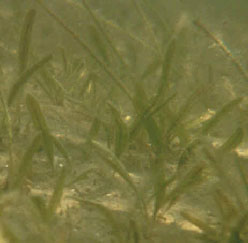- Halophila johnsonii
Taxobox
name = Johnson's Seagrass

image_caption = Closeup of a bed of Johnson's Seagrass
regnum =Plant ae
divisio = Magnoliophyta
classis =Liliopsida
ordo =Alismatales
familia =Hydrocharitaceae
genus = "Halophila "
species = "H. johnsonii"
binomial = "Halophila johnsonii"
binomial_authority = Eiseman and McMillan
status =Johnson's Seagrass ("Halophila johnsonii") is a small, asexual
seagrass in the familyHydrocharitaceae (the "tape-grasses"). It occurs only on the southeastern coast ofFlorida , and was the first marine plant listed on the United States endangered species list, where it is listed as a threatened species. Female flowers have been observed, but even with decade long observational studies, neither male flowers nor seed have ever been observed. National Marine Fisheries Service. 2002. "Recovery plan for Johnson's Seagrass ("Halophila johnsonii")". Prepared by the Johnson's Seagrass Recovery Team for the National Marine Fisheries Service, Silver Spring, Maryland.]It may have the most limited distribution of all seagrasses. It occurs only in lagoons along roughly 200 km of the Florida coastline between
Sebastien Inlet and the northern part ofBiscayne Bay , where it grows in small patches of a few centimeters to a few meters in diameter at depths ranging from the intertidal zone down to 3 meters.Prior to 1980, the species designation was uncertain. It was sometimes referred to as either "Halophila decipiens" or "H. baillonis" Ascherson, despite most closely resembling "H. ovalis".
Morphologically, Johnson's seagrass is recognized by the presence of pairs of linearly shaped foliage leaves, each with a petiole formed on the node of a horizontally creeping rhizome. The rhizome is located at or just below the sediment surface and is anchored to unconsolidated substrate by unbranched roots. The leaves are generally 2-5 cm long (including the petioles), and the rhizome internodes rarely exceed 3-5 cm in length, making this species appear diminutive relative to the larger seagrasses.
Both the
Green sea turtle and theWest Indian manatee are known to feed upon the plant, as well as someherbivorous fish. However, the main threat to species survival is probably human activity.References
Wikimedia Foundation. 2010.
